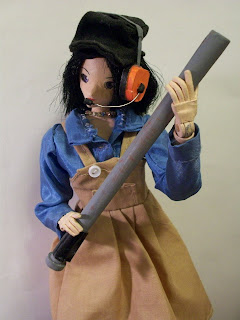I've always hated three parts of the doll making process:
- Joint cap covers for the screws
- Making the ball joints work
- Making the head
The head's a pain to do since you want it to look nice, and it gives the final product its character. I've gotten extra picky with how the head went this time, since I'm trying to go for something similar to an established character design. I went through three tries before settling on one I liked. As usual, I settled on the old
Ruri template although I now have
newer alternatives. (Note: the old headmaking post is now out of date. This will update the newer techniques.)
After tracing the template onto some
Muck Rats, I sanded the pieces down lightly to remove the shiny varnish. Each part was then assembled by placing printer paper strips on the inner side. I did the face as one single part, and the back of the head as two parts: upper and lower. This time, I was zealous with the pre-sanding to remove the rough edges. I covered the seams with more printer paper strips and sanded those down by hand. I found that coating the paper with a thin layer of glue before sanding with a Dremel also gets nice results, as the paper holds its integrity better.

Here are some of the development stages. From the left: First iteration, deemed too pointy and narrow; Second iteration, deemed too fat and odd shaped; test build from Moekami's newer models, deemed unusable due to extra pointy elements; Third iteration, the final build.
The difference from the first two iterations is the addition of extra mass to round out the head. This was done with layering 110lb cardstock over the regions needed to bulk up and carefully grinding them down with a Dremel. Printer paper works well for concealing small blemishes and smoothing out transitions made too rough with the Dremel. The third time, I got something I liked.

I didn't succeed in finding a hair donor in time. Therefore, Aelia has short white cardstock hair for the time being. They're quite pointy. I opted for a different hair technique than the first iterations of hair. Her eyebrows are actually Magic: the Gathering cards. Decided to try glue-on eyebrows this time. Aelia suffers from the problem of always looking unhappy when you look down on her. Then again, you'd be too.

This is the reason why this revision was called Aelia. I'm actually going to attempt to make her as Aelia from Valkyrie Profile, the green armored polearm wielding character. This, is her spearhead, which consumed about 6 MtG cards. There's a lot of details that I tried my best to capture. A Dremel was used to grind out the rough shapes and curves, and the little grooves were hand cut with an X-Acto knife. The curved coil consists of four strips of Magic card, 5mm wide. The strength of the coil has yet to be tested. It should be noted that Aelia's spear in the concept art has the coil unsupported from end to end, so it is a very unstable means of attaching the spearhead to the shaft. It would likely flex and have a higher chance of breaking, as it will behave like a spring than a solid shaft.

The shaft consists of two bamboo sticks linked together at the second hand hold to provide an overall shaft length of 28cm. The grip regions are rolls of 110lb cardstock. I'll be adding details to the individual sections once I've figured out the spearhead.

Unfortunately, the bamboo sticks aren't perfectly straight. Not that you can tell easily.

Aelia's body isn't the delicate, thin frame used for Hotaru and Lia, but the more stocky build BBI's doll has. It's still compatible with all the existing elements made for Hotaru. I'll have to field test her joint stiffness over the next month to see if the new joint construction methods and layout can support the added mass and the usual fatigue and wear.
 Right now, I have the chest plate, waist segments and hips structurally completed. I'm experimenting with the skirt plates and the arm sections. Nothing like using a lot of thermal paper and masking tape to complete my armor. Reminds me of my high school crafting days.
Right now, I have the chest plate, waist segments and hips structurally completed. I'm experimenting with the skirt plates and the arm sections. Nothing like using a lot of thermal paper and masking tape to complete my armor. Reminds me of my high school crafting days.




















